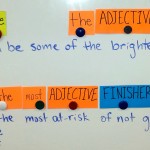In my previous two “back to schools” blogs, I focused on bringing back librarians and basic supplies such as tissue. I struggled more for the third topic, because the obvious choice seemed to be to bring back teachers! Recently the media has been covering Arizona’s dire teacher shortage, and my colleagues have written so well about it that I can just suggest you read their posts (see September).
So I am going to mention two other things we have lost which need to come back to schools.
The first is full-day kindergarten. Arizona has not funded full-day kindergarten for over five years. Some districts offer it, at the expense of other budget items, in order to be competitive and keep families within the district. But as time goes on and money gets tighter, more districts are beginning to charge for the full-day programs.
Perhaps if we were in a time of greater income equality, the impact of having a shorter kindergarten day would be minor. However, Arizona has high levels of children living in poverty, which puts them at risk. If we expect kids to rise to new, higher standards, we need to provide them with the services and education that will help them overcome obstacles. And it is an era of greater expectations as well.
My second suggestion seems a bit less essential. However, I think it is something easy to forget we ever had. Let’s bring back Spanish and other world languages into elementary school. Does anyone else remember those times back in the ‘90’s when many districts offered a Spanish program to elementary students? It was another “special” like music and art. Research generally shows that learning a second language helps students cognitively and socially. We know that. We also know that if we want our adults to be bilingual, they will become more fluent in a language if they receive instruction in that language throughout school. Very few schools offer second language instruction in the early grades.
Here’s what I wonder: Would my students, junior high English Language Learners, the ones who have been stuck at the intermediate level for a few years now, be more proficient in English if they had learned Spanish in school? I mean, they speak Spanish, and view television and often Youtube in Spanish, but what if they were to have learned to more academic and formal language structures? What if they hadn’t become stuck between two literacies, only partially proficient in both?
There is a group of students who have lost more than I can measure because they have spent the past few years understanding only a small part of what they have been expected to learn. They have missed out on math skills, history, literature and science, not to mention concepts in art, music and perhaps even health. When we sit to read literary or informational text, they lack background knowledge that other students often have, which makes it harder for them to connect to what they are reading and build an interest in what comes next, an interest which might propel them through the unfamiliar vocabulary toward comprehension. Although they have great potential and deserve the best, it is a slow path toward proficiency. Students who have gone to school in their first language up through the elementary years seem to have an easier time, because they have background knowledge and solid language skills (though not in English).
Elementary Spanish would not remedy this issue, but in addition to its other benefits to all students, it might give at least the majority of Arizona’s English Language Learners a chance at continuing to learn important concepts and ideas (by reading more in Spanish) as they work toward English proficiency. I am also guessing that the attention paid to grammar concepts would help them understand both languages better.
At any rate, given our proximity to Mexico and the interconnectedness of our economies and cultures, knowing more ways to communicate can only be a good thing.
There are so many things our schools have lost that we could use back, but it will soon be October, and is no longer “back to school.” So on to other topics and other blog entries… with the final thought that many of the things schools need are not things we have lost, but ideas and practices with brand new potential that were never part of schools in my youth. These ideas represent new frontiers.(And they will need funding, too.)









Comments 3
I sometimes wonder if our educational shifts are so extreme that good programs lose importance when they are not “trending”. The focus on STEM and STEAM is proving to have long-term benefits, but I wonder about liberal arts and language programs too. One of the most common teacher concerns is that there’s not enough time to do it all, and it’s interesting to see how that’s proven true when we make these big shifts from one decade to the next.
I love that you tackled this topic from a few different perspectives. Learning a second language used to seem so important, and in some parts of the country it is still a critical part of elementary educational offerings. In states with classroom language policies, it make these kinds of offerings in the public school difficult if not impossible.
The way that some states look at supporting ELL students can make a vast difference in the quality of their education and the acceptance that they feel. You raise very valid points for discussion in this post.
This was a fantastic post — I really enjoyed reading your thoughts. As a college student, I sincerely wish that I had been exposed to Spanish from an early age. That is why I think that foreign languages should be brought back in to the elementary school classroom: the benefits just seem to be so plentiful (and with few drawbacks).
When students are exposed to foreign languages at an early age, they have a much better chance of becoming fluent.
Once again, great post!